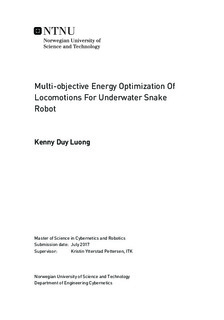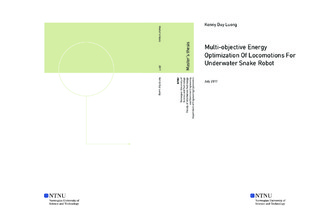| dc.description.abstract | Biologically inspired Autonomous Underwater Vehicles (AUVs) have been developed in the recent decades. This thesis focuses on the \glspl{auv} that are biologically inspired by snakes, called Underwater Snake Robots (USRs). A well-known issue of the USRs, or any AUVs, is the long-term autonomy. To achieve this, energy efficient approaches are required. Many studies have considered single-objective optimization problems regarding the energy efficiency of the USR, but almost none with Multi-Objective Optimization Problems (MOPs). This thesis presents MOPs of different locomotions of the \gls{usr}. The presented \glspl{mop} consider the energy efficient optimization of maximizing the forward velocity, while minimizing the power consumption of the USRs. For computing the efficient motion patterns, two Multi-Objective Evolutionary Algorithms (MOEAs) called Non-dominated Sort Genetic Algorithm II (NSGA-II), and Multi-objective Optimization (HypE) are applied. A challenging topic of the USR, is their adaptability of different locomotions. Different locomotions of the USR give rise to different search spaces for optimization. We present simulation studies of the two most common snake locomotions: (i) lateral undulation and (ii) eel-like motion. Furthermore, we also present and investigate three altered motion pattern of the USR. The aim of the altered locomotions is to let the MOEAs generate efficient locomotions through evolutionary, which we do not know the gait of. From the simulation results, it turns out that one of the altered motion pattern approximates a motion similar to the lateral undulation. This motion pattern is generated based on Fourier series. The obtained simulation results are based on optimization with optimal Genetic Algorithm
(GA) parameters, found by numerous presimulations of the MOPs. Since this is multi-objective optimization problems, the end results will be in the form of Pareto fronts. These Pareto fronts can be used as trade-offs for selecting the forward velocity and power consumption of the USR. Additional to the optimization results of the MOPs, we present multivariate analysis of the simulation results using Principal Component Analysis (PCA), for finding relationships between the motion patterns. Furthermore, through the analysis, some assumptions on the shape of the altered locomotion can be given. Based on the results from the PCA, we also present regression models computed by Partial Least Square Regression (PLSR) for predicting the optimal gait parameters using the objective values from the Pareto fronts. | |

